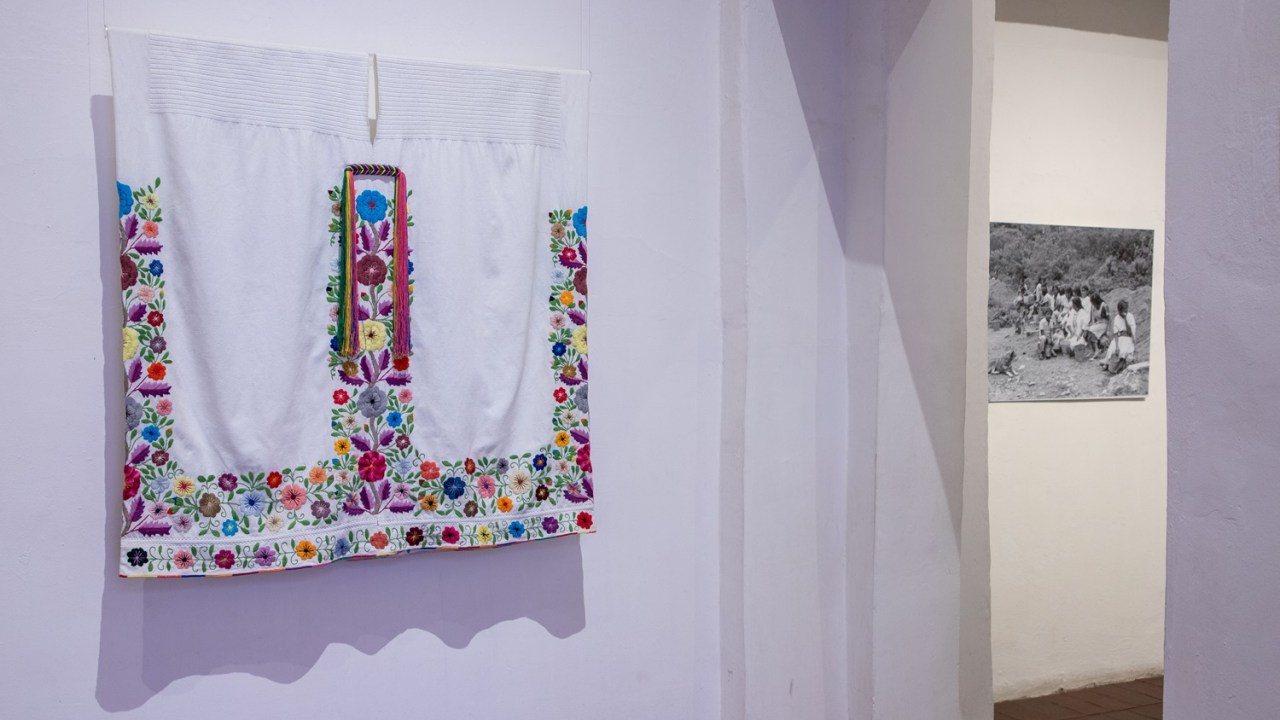
Who decides how a body is represented inside a museum?
This article first appeared in the journal Exhibition (Spring 2024) Vol. 43 No. 1 and is reproduced with permission.
Museums, as institutions that sustain a certain visual order, have their foundations in colonial structures. Indigenous communities from diverse territories have been evidencing and questioning this relationship for several decades. Cultural anthropologist Nancy Marie Mithlo (Fort Sill Chiricahua Warm Springs Apache) and Native American art specialist Yve Chavez, address this relationship through the ways in which histories are told in art institutions: “by examining closely the tools available to engage with the complexities of our collective histories, however contested.”[1] One of these tools, so ubiquitous as to almost appear invisible, or at least, inevitable, is the mannequin. But, as cultural historians Bridget R. Cooks and Jennifer Wagelie rightly point out, “mannequins…are not neutral objects…. Mannequins have long histories of being used to promote colonialism, consumerism, and racism.”[2]
It is along these lines that we ask ourselves about the way in which the bodies, desires, and very presence of contemporary Indigenous communities establish a dialogue with the different infrastructures of museums and the possible affordances that these can facilitate. Here, we adopt anthropologist and filmmaker Paul Basu’s concept of affordances as the possibilities that may exist in remobilizing museum collections to speak from a critical stance about narratives that contribute to rectifying, restituting, and repairing histories of dispossession within the colonial order.[3]
In this essay, we will focus on the use of mannequins as a textile display device in two exhibitions at the Museo Textil de Oaxaca (MTO) in Oaxaca de Juárez, Mexico, and the affordances we attempted to create in each case. But first, it is necessary to understand a bit more about the long history of mannequins in museums and their colonialist and racist roots.
Bodies and/as Objects: Mannequins in 19th- and 20th-Century Displays
The body was first introduced into the museum exhibition system during the 19th century, a time when imperial nations hosted world fairs and exhibitions.[4] Religious institutions also played an important role in the inclusion of the “foreign/other” body as an object of exhibition. At first, these exhibitions consisted only of objects, but to attract a larger public, they began to include people, dioramas, and sculptures representing the inhabitants of the communities in question.[5] It is within the framework of these fairs and exhibitions that European nations began to present people from Indigenous communities from different regions of the world as part of the objects on display.[6]
Over time, these events gave rise to anthropological museums whose objective was to represent the “different human races and their lifestyles” from an apparently scientific point of view. Early efforts to represent the body within such institutions favored the use of hyperrealistic mannequins, which were created in a variety of ways, including:
- The interpretation of facial casts, photographs, and drawings of individuals by the technical staff of museums.
- The mixing of facial casts of Indigenous people with body casts of anthropologists to create hybrids.[7]
- The use of complete casts taken directly from the bodies of people native to the places represented.[8]
In the 20th century, these almost mimetic forms gave way to more abstract representations that favor a supposedly “neutral” approximation of human characteristics. In 1939, British curator Anne Buck, while visiting Scandinavian museums, commented that the clothing of the elite was displayed on headless mannequins, while peasant garments were mounted on mannequins that did have heads. In addition, folk costumes were shown in settings that included people’s surroundings (a house, for example), while the costumes of the upper classes did not include a spatial context, but instead were appreciated on their own, as art objects.[9] This differentiation is still at work today, as anthropological or ethnographic museums tend to favor the inclusion of dioramas and mannequins that resemble “reality,” and art museums presenting a textile or fashion exhibition tend to use tall, thin, white, and abstract mannequins without hair or facial expressions.[10] But, as professor A. Dana Weber and others have argued, these featureless mannequins are also problematic:
Precisely the lack of personal information in the mannequin constitutes a major point of critique for this medium because such a depersonalized mode of representation is not only guided by but also invites an objectifying, oftentimes colonial, and levelling perspective in contemplation.[11]
So, if mannequins have been used for over 100 years to emphasize differences between individuals and the objects presented on them, a few questions need to be considered:
- When talking about “ethnographic textiles” versus “fashion textiles,” who wears what and in which contexts?
- Today, in the 21st century, would an “ethnographic textile” be presented the same way within an anthropology museum and a design museum?
- Which bodies are desirable under specific contexts?
- Who chooses which bodies are represented and under which terms?
At the same time–and paradoxically–mannequins have the potential to homogenize the body and to harbor a series of fantasies about it:
Such objects pose a major paradox: their three-dimensional human appearance occasionally overshadows their designated function as display aid for original ethnographic objects, so that audiences might only too easily mistake them for the display goals instead. In other words, the human likeness and tangibility of the mannequin inadvertently complicates its exhibition purpose…with significant consequences for the interplay between fact and fiction in the production and reception of these museum displays.[12]
If we accept that museums are part of the power structure that supports a certain visual order, we will have to ask ourselves which bodies and which stories have been prioritized in these installations and why. How is otherness represented? How are textiles exhibited when they pass from one visual economy to another? What are the political implications? To explore these questions in the contemporary context, we turn now to our case studies.
Silver, Glass and Cotton: Indigenous Costumes, Depersonalized Mannequins
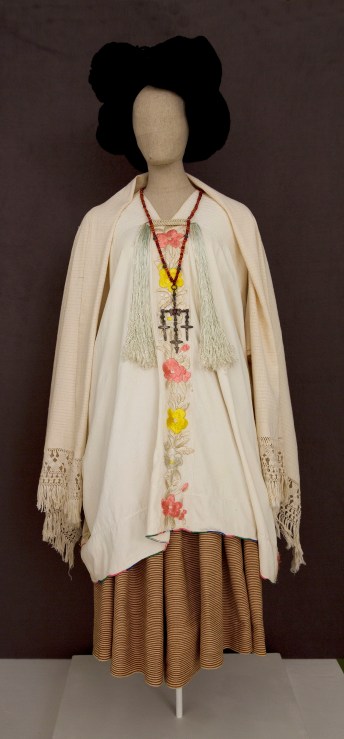
MTO’s 2013 exhibition, Silver, Glass and Cotton: The City Reflected on Indigenous Attire in Oaxaca, addressed the impact that goods and materials produced in urban areas–such as cotton fabrics, glass beads, and silver pendants–had on the clothing of different communities.[13] The exhibition included garments, headdresses, and jewelry that formed 18 ensembles. Although this exhibition was developed entirely by MTO staff–which did not include any individuals from the communities represented–the team conducted extensive research and consulted with numerous long-time friends and collaborators: women from the communities whose costumes were going on display, who guided staff on the correct placement of the different garments and headdresses.[14]
Silver, Glass and Cotton employed economical half-body (head and torso) mannequins made of Styrofoam that were readily available in Oaxaca and easy to manipulate through the addition or subtraction of material to quickly transform their original shape. Given the number of required mannequins, time constraints, and our available staff, these ready-made mannequins were the obvious choice. We covered all the mannequins with ecru-colored linen fabric, sewed black acrylic yarn on the heads to simulate hair and facilitate the placement of the headdresses, and left the faces featureless (fig. 1).
The press gave the exhibition good reviews, and most visitor comments were also positive. None of this feedback, however, mentioned the mannequins. The only feedback we received directly related to the mannequins was from a visitor on a guided tour who said that the fact that all the mannequins looked the same, with no facial expressions and the same height and volumetric shape, made the show feel like a fashion show, as opposed to an ethnographic show, where some diversity in heights, body complexions, and facial expressions is expected.
Lhall xallona llun lliu’ tuse, llunen lliu walh: Using Display Techniques
While Silver, Glass and Cotton included a complete costume from the Zapotec community of Yalálag, MTO staff were responsible for all curatorial decisions and overall guidelines for the exhibition design, with no local women involved in these processes. When MTO displayed items from Yalálag almost 10 years later, our approach was radically different.
2022’s Lhall xallona llun lliu’ tuse, llunen lliu walh / Dressing is also a territory of struggle was curated by the Dill Yel Nbán Collective.[15] The exhibition’s main narrative was the dispute over the narratives of the history of the Zapotec peoples of Yalálag and Betaza, both Indigenous communities of the northern mountains of Oaxaca. The Collective, made up of people from the communities of Yalálag and Betaza, proposed the terms and rhythms of this narrative, and its implementation within the exhibition demonstrates how we–MTO staff and our partners–embraced the idea of collectivity in the way we researched, wrote, and problematized the reflections triggered by the objects and collections to which we had access.
The exhibition, which included textiles, historic and contemporary photographs, and archival materials, sought to assemble different institutions, objects, and interests in one curatorial narrative. Historic photographs and archival materials are often ethnographic and anthropological in nature, and, as such, the individuality of the portrayed subjects was not deemed important. In consequence, these materials often have the same effects as dioramas and hyperrealistic mannequins, since they present people from a gaze toward the other. To counteract this effect, two Zapotec artists with close ties to the Collective contributed contemporary photographs to the show. Yalalteca photographer Citlali Fabián contributed works from her series, My family album, and Collective member Victoria Gaspar displayed photographs of her family, in particular an image of her grandmother, Dolor Laga (fig. 2). By juxtaposing the anonymity of the majority of our archival images, which come from an external view toward Indigenous communities, with the affective view of these Indigenous artists, whose works engage with the memory, closeness, and agency of the people in the photograph, the exhibition sought to reinforce the contrast between the two approaches.
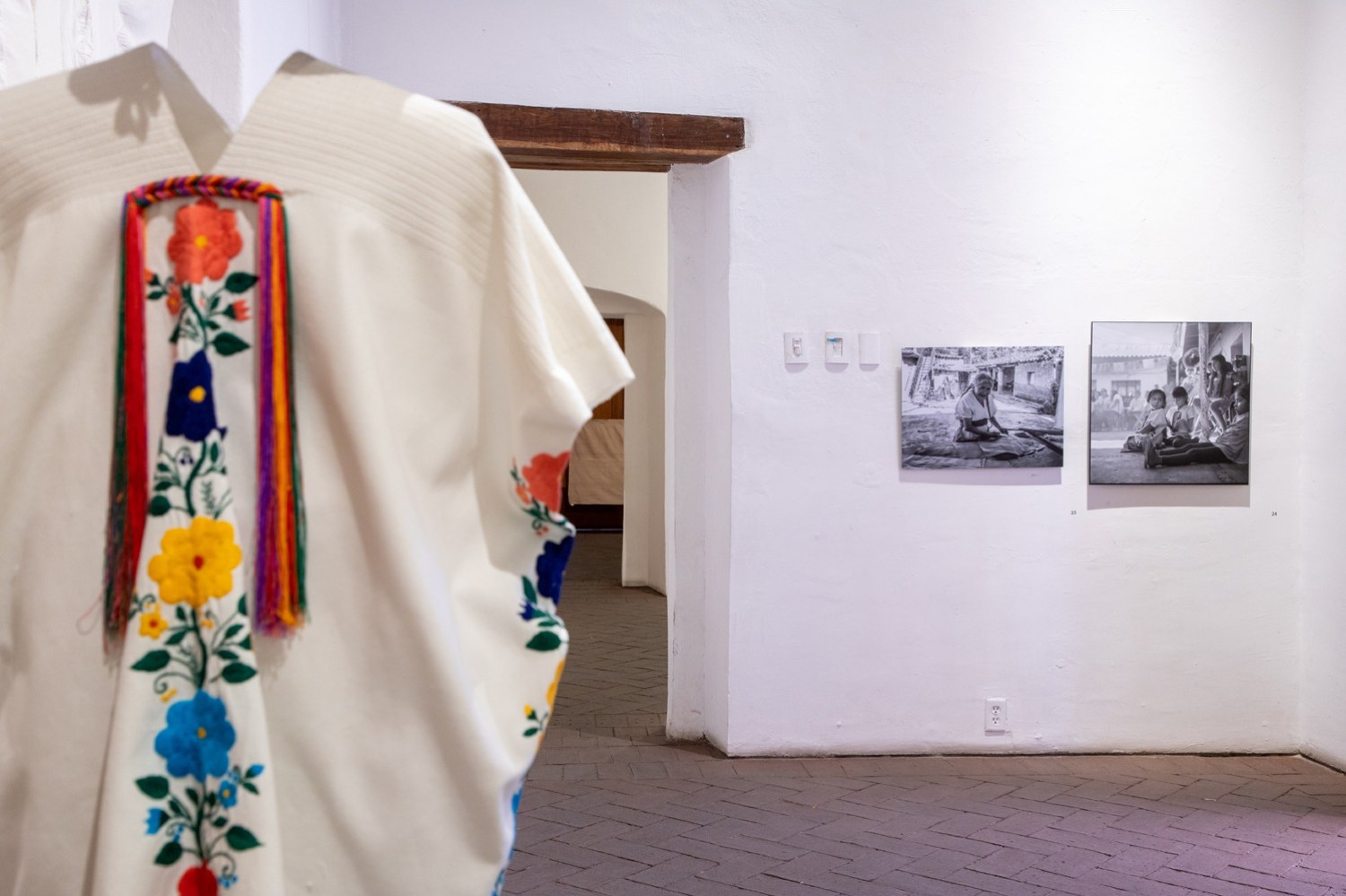
Lhall xallona llun lliu’ tuse, llunen lliu walh included four ensembles that were put together using textiles on loan from different families, as well as textiles from MTO’s collections. While the Dill Yel Nbán Collective curated the exhibition, the show’s design was a joint exercise between the Collective and MTO staff. As in the 2013 exhibition, women from the communities represented, as well as family and friends of the Collective, participated in the correct mounting of the garments during installation. On this occasion, the sets of clothing were presented in three distinct ways:
- Mounted on “invisible” mannequins. This involved the creation of hollowed-out structures made of polyethylene foam, FOSSHAPE, and cotton muslin.[16] For the headdresses, we created concave FOSSHAPE bases lined with black polyester fabric onto which we sewed black acrylic yarn to simulate hair. These structures provided volume to the garments displayed on them without the appearance of a “body” (fig. 3).
- Two-dimensionally. The second method chosen presented the garments hanging along the walls, as paintings are exhibited (fig. 4).
- Deconstructed. Some textiles were even presented in an abstract way, so that visitors could appreciate their materiality and total length. For this purpose, traditional textile mounting systems were used, such as the use of Velcro tapes and acrylic tubes (fig. 5).
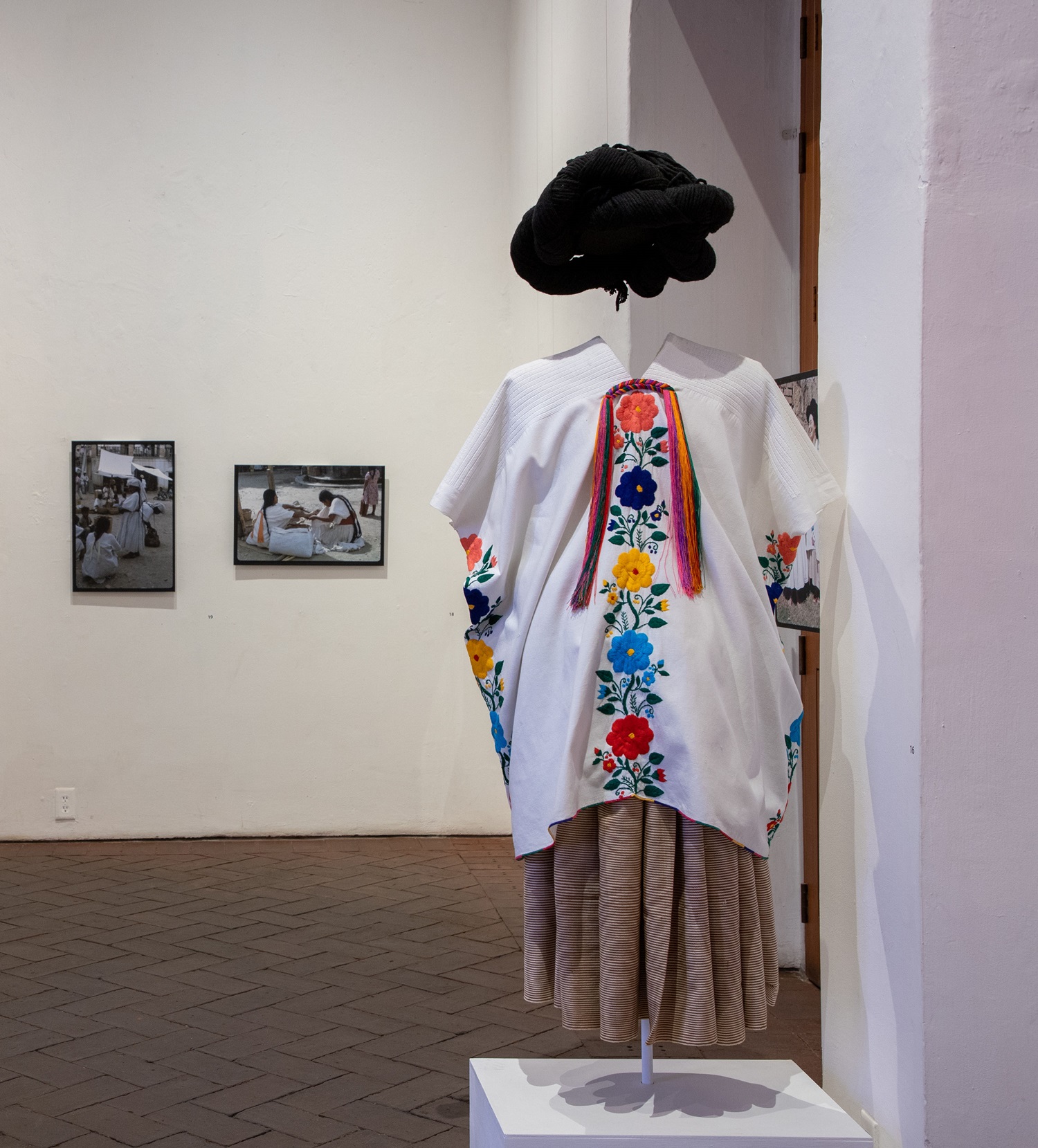
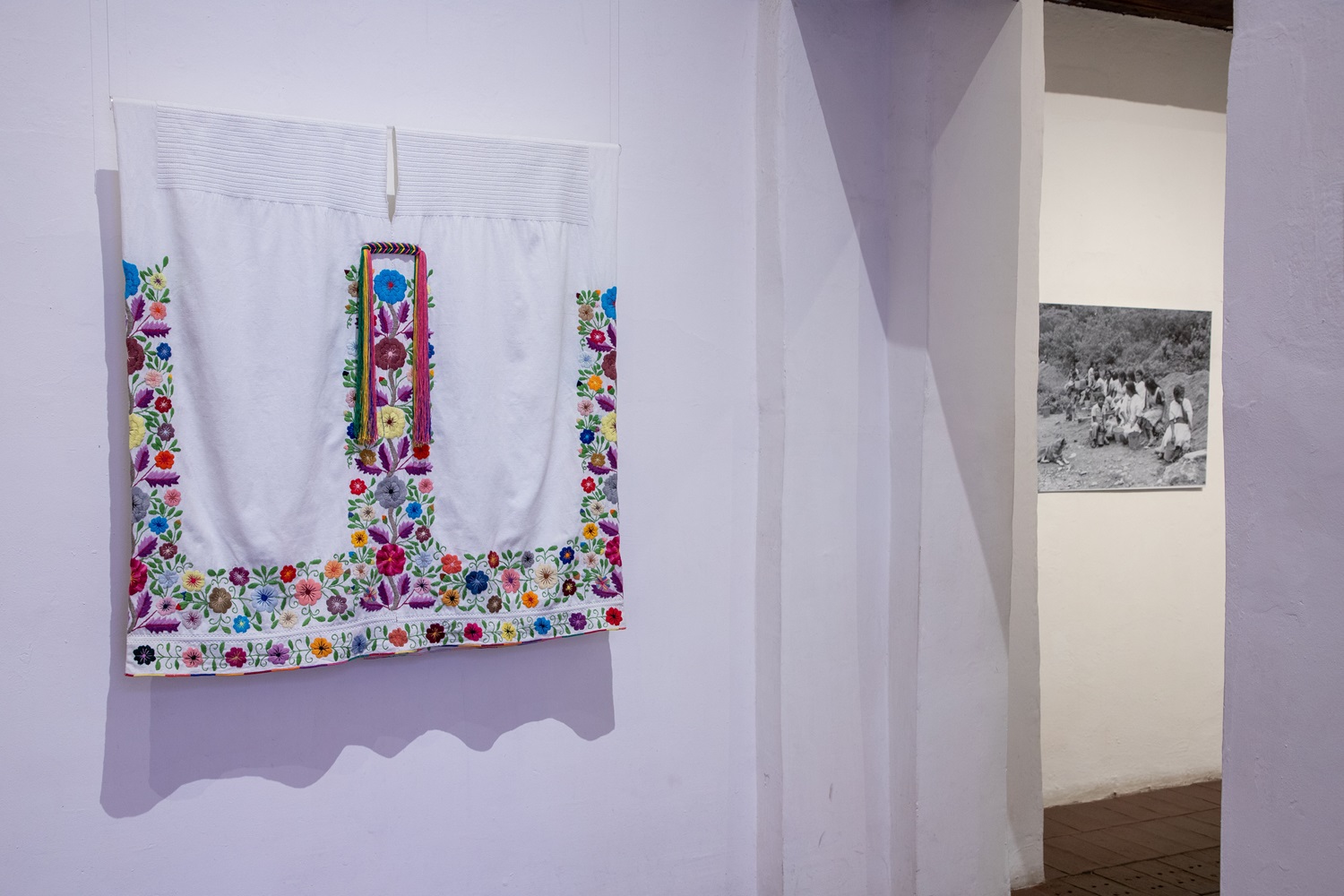
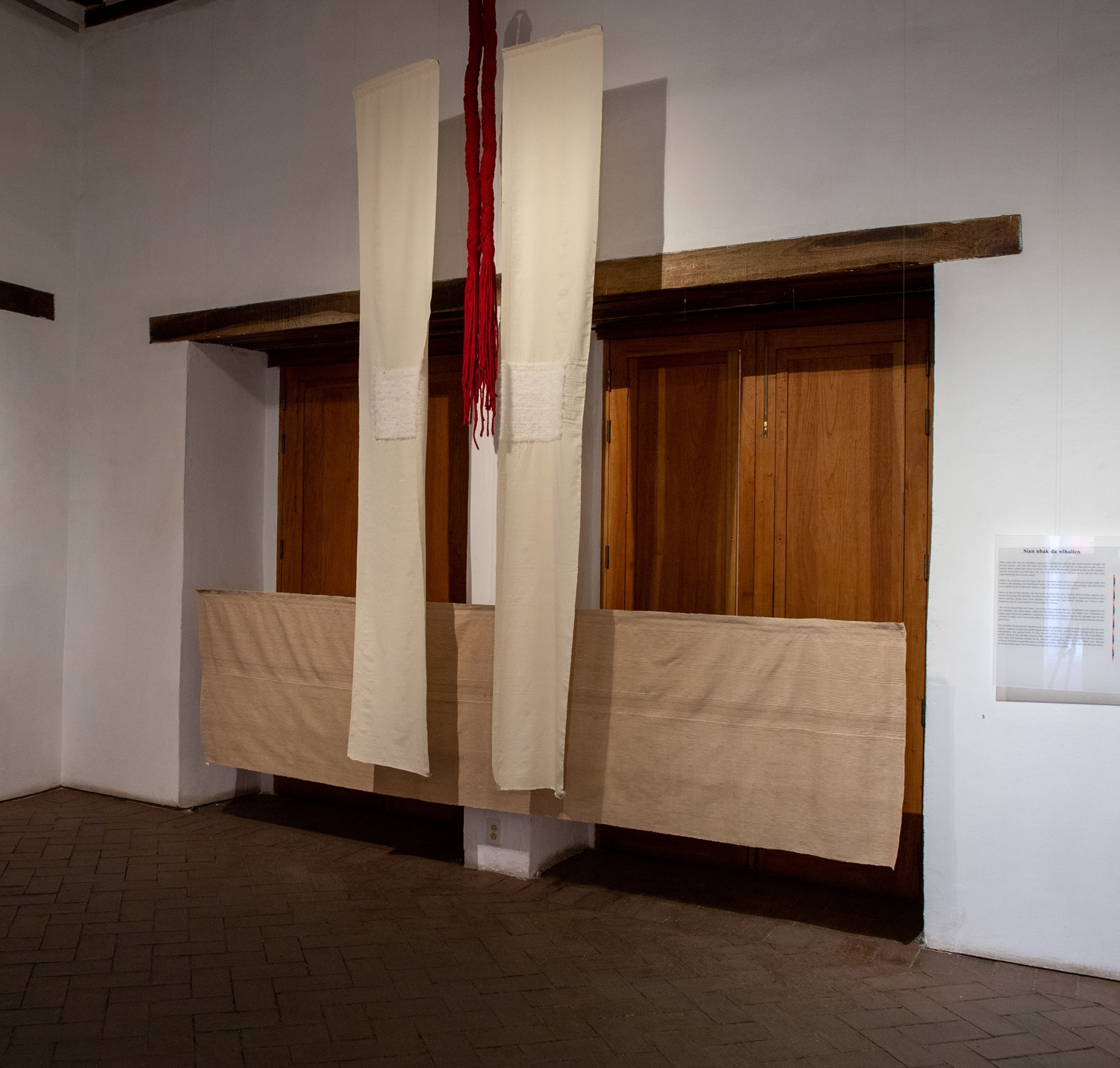
All these methods of display present us with their own unique questions and problems. For the Collective, showing the diversity of options was a way of making explicit the problem of “putting the body” in a museum and revealing that, despite having multiple ways of addressing the issue, presence and narratives remain contested territory. In Lhall xallona llun lliu’ tuse, llunen lliu walh, the Collective sought to show how the history of textile use is deeply intertwined with the struggles of Indigenous peoples to exist. In this sense, the word dress, as a space of dispute–in terms of bodies, presence, and agency–made sense within the museum.[17]
Implications
Curatorial and exhibition-design strategies that are cocreated with affected communities raise various questions that point to the fact that the narratives in museums may be diverse, respectful, and propose alternatives to those historically ingrained in our field, for example:
- What forms of representing Indigenous communities’ complex histories could be critical of the history of textiles, their collection, and their exhibition?
- For whom are these new readings necessary?
- How does one speak of the history of dress without the bodies that activate it?
- Is there an intermediate level between the lack of personalization of a mannequin and the hyperrealism to which museums have resorted?
In the end, it all comes down to a problem that implies the representation of living peoples.[18]
To briefly recap: On the one hand, we have the mannequins that come from the anthropological and ethnographic context, which, in their scientific and pedagogical efforts, ended up constructing a fictitious image, full of colonial fantasies of what the colonizer imagined of the other. From this lens, these mannequins are a forceful reminder of the symbolic violence experienced by racialized bodies whose use also reaffirms, in a visual way, the theories of scientific racism and physical anthropology. Currently, if choosing this type of mannequin, it is essential to consider the ease with which this device can contribute to the perpetuation of stereotypes. On the other hand, we have the mannequins that converse more with the fashion system, which are informed by notions of desirability that set a “neutral” hegemonic body in contrast to the racialized body. Thus, we have ethnographic mannequins that reaffirm the otherness of their subjects through their extreme attention to detail, specificity, and difference, and fashion mannequins that–through their presentation of apparently neutral (or rather, normalized) bodies–direct our imaginations toward objects of consumption that we desire. In the end, neither system is free of problems, which forces us to return to the question of our responsibility:
- What is the narrative impact of exhibiting an ensemble created and used in an Indigenous community on one type of mannequin over another?
- What are the implications of dressing hegemonic bodies with objects from Indigenous communities in a museum context?
- Who is being appealed to and for what purpose?
- What identities are erased in each case?
What new possibilities open up when we reject both of these systems as insufficient to the task of representing the absent body of Indigenous communities within our museums? In Lhall xallona llun lliu’ tuse, llunen lliu walh, we resolved this question in two ways: through the “invisible” mannequins–those that did not show heads, necks, or limbs; and through the “abstract,” two-dimensional installations that eliminated the mannequins entirely, but at the expense of the presence and three-dimensionality a garment takes on when it is worn. In both cases, the body disappears. These decisions, made with MTO’s curatorial partners in the Collective, sought precisely to highlight this absence of the Indigenous communities, not to mention the objects’ disassociation from their vital functions once they entered the collections of museums and other institutions. Twisting traditional displays to raise issues of this kind made it all the more important to include carefully selected archival materials, particularly photographs and documents (historical, contemporary to the garments exhibited, and/or current) within the exhibition to assist visitors in understanding the relationship between textiles and the body.
Final Questions
It seems to us that the stakes in these methodological shifts concern not only how textiles are shown, but also to what end and for whom they are shown. Do we want to bring the body into the museum? Why? Mannequins are not neutral objects: they validate certain typologies of bodies while perpetuating the marginalization of others. This difference influences the public attending an exhibition, consciously or unconsciously, and this, in turn, affects the concrete lives of the people represented: some of them will continue to be aspirational models, while others will continue to be racialized.[19]
What possibilities do we have? Robotics and artificial intelligence (AI) systems should make us particularly skeptical: although they may seem very different from the mannequins of the 19th century, they share one fundamental trait–their underlying racism. The use of AI for the creation of mannequins or in the solving of other exhibition-design challenges could easily lead to the perpetuation of stereotypes, as we again see a technology being developed almost exclusively by white men.[20] And the technology sector is not so far removed from museums and academia, worlds that are themselves still dominated by white men (and to a lesser extent, white women). So, the question is once again: Who decides how a body is represented inside a museum?
A relatively simple solution would be an ongoing dialogue with people from the communities of origin of the textiles to be exhibited, to open the decision-making process to a more diverse group. For this to happen, it remains necessary to question the infrastructures and affordances that a museum can offer. The presence of collectivities in museums must be considered in terms of methodologies, resources, and possibilities so that they do not perpetuate power structures within their practices.
It is true that dialogue is necessary and beneficial, but it is equally important to recognize that the history of museums and their display devices are deeply rooted in the colonial and racist system. Anthropology, natural history, and art museums are so strongly rooted in these structures that they seem to have no need to question the use of mannequins, to the point of proposing this as the only correct, serious, and professional way of presenting textiles from Indigenous peoples. Our proposal is to encourage critical dialogue between various institutions and agents to find points of agreement and compromise, with full awareness that the results that work for one group may not work for another. How can we, while recognizing the complexity and deep-rooted nature of the problem, suggest an alternative reality that can move beyond mannequins to address objects and the communities they come from in nuanced and mutually affirming ways? Although there is no single recipe for this, the voices and agencies of the communities in question cannot be omitted, since it is only through collective work that the problems and necessary solutions to specific contexts can be raised through careful curatorship and horizontal dialogues.
[1] Yve Chavez and Nancy Marie Mithlo, “Introduction: The Unknowable Known Past,” in Visualizing Genocide: Indigenous Interventions in Art, Archives, and Museums, ed. Yve Chavez and Nancy Marie Mithlo (Tucson, AZ: University of Arizona Press, 2022), 3–16.
[2] Bridget R. Cooks and Jennifer J. Wagelie, “Introduction,” in Mannequins in Museums: Power and Resistance on Display, ed. Bridget R. Cooks and Jennifer J. Wagelie (London and New York: Routledge, 2021 [Kindle edition]), 2.
[3] Paul Basu, “Re-mobilising colonial collections in decolonial times: exploring the latent possibilities of N. W. Thomas’s West African collections,” in Mobile Museums: Collections in circulation, ed. Felix Driver, Mark Nesbitt, and Caroline Cornish (London: UCL Press, 2021), 44–70, https://doi.org/10.2307/j.ctv18kc0px.9. Basu defines affordances as “emergent, relational entities, determined jointly by the distinctive properties of the object or environment, the specific circumstances in which those properties are perceived, and the abilities and intentions of the actor perceiving them” (46).
[4] For an interesting discussion of the relationship between textiles, bodies, and colonial power in world exhibitions, see: Victoria L. Rovines, “Cloth, Clothing, and Colonial Power: France and West Africa at the Expositions,” in Visual Typologies from the Early Modern to the Contemporary: Local Contexts and Global Practices, ed. Tara Zanardi and Lynda Klich (Milton Park, UK: Routledge, 2021), 214–28.
[5] Luis A. Sánchez-Gómez, “Human Zoos or Ethnic Shows? Essence and Contingency in Living Ethnological Exhibitions,” Culture & History Digital Journal 2, no. 2 (December 2013): 17, http://dx.doi.org/10.3989/chdj.2013.022.
[6] Kyunghee Pyun, “Asian Physiques of Mannequins in American Art Museums,” in Mannequins in Museums, 79.
[7] Gwyneira Isaac, “From life? Histories and Contemporary Perspectives on Modeling Native American Humankind through Mannequins at the Smithsonian,” in Mannequins in Museums, 32–3.
[8] Jessica Stephenson, “The Museum Mannequin as ‘Body Without Organs,’” in Mannequins in Museums, 12.
[9] Pyun, “Asian Physiques of Mannequins in American Art Museums,” 82.
[10] Emma McClendon, “Fashion and Physique: Size, Shape, and Body Politics in the Display of Historical Dress,” in Mannequins in Museums, 63.
[11] A. Dana Weber, “Vivifying the Uncanny: Ethnographic Mannequins and Exotic Performers in Nineteenth-Century German Exhibition Culture,” in Fact and Fiction: Literary and Scientific Cultures in Germany and Britain, ed. Christine Lehleiter (Toronto: University of Toronto Press, 2016), 305–6, https://www.jstor.org/stable/10.3138/j.ctt1kk65r7.17.
[12] Ibid., 298.
[13] See: “Plata, vidrio y algodón: Reflejos de la ciudad en los atuendos indígenas de Oaxaca,” Museo Textil de Oaxaca, accessed August 21, 2023, https://museotextildeoaxaca.org/plata-vidrio-y-algodon-reflejos-de-la-ciudad-en-los-atuendos-indigenas-de-oaxaca.
[14] This active collaboration could not be carried out in all cases for lack of contacts in some of the communities in question.
[15] Dill Yel Nbán Collective is a group of Zapotecs from the northern mountains of Oaxaca dedicated to the research and dissemination of the Zapotec language and culture. Dill Yel Nbán’s members are Yunitza Vásquez, Ana Ortiz, Ángel Bautista, Victoria Gaspar, Sandra Ortiz, and Ariadna Solís. For more, see: “Lhall xallona llun lliu’tuse, lunen lliu walh,” Museo Textil de Oaxaca, accessed January 31, 2024, https://museotextildeoaxaca.org/lhall-xallona-llun-lliutuse-llunen-lliu-walh.
[16] FOSSHAPE is a non-woven, felt-like fabric made out of polyester fiber that becomes rigid once it is subjected to heat and pressure.
[17] For further discussion, see Ariadna Solís, “Lhall xallona llun lliu’tuse, llunen lliu walh / Vestir también es un territorio de lucha: Curadurías colectivas e investigaciones transdisciplinarias,” Iberoforum. Revista De Ciencias Sociales 3, no.1 (September 2023): 1–29, https://doi.org/10.48102/if.2023.v3.n1.274.
[18] Deborah Dorotisnky, “Fotografía y Maniquíes en el Museo Nacional de Antropología,” Luna Cornea 23 (2002): 60–65.
[19] Cooks and Wagelie, “Introduction,” 7–9.
[20] Cade Metz, “Who Is Making Sure the A.I. Machines Aren’t Racist?,” The New York Times, March 15, 2021 (updated June 23, 2023), https://www.nytimes.com/2021/03/15/technology/artificial-intelligence-google-bias.html.

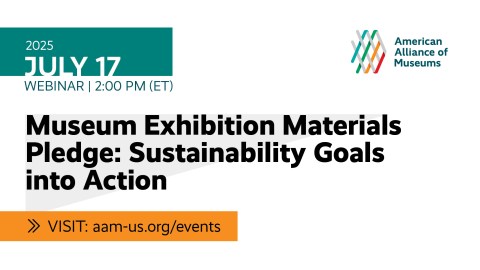



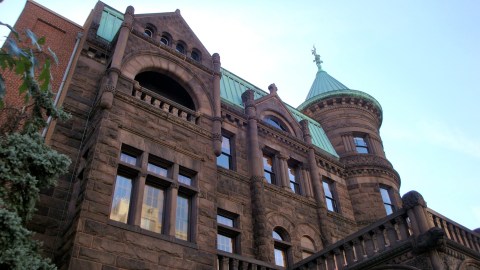


I don’t think white people see the mannequins. I think hanging clothes on a mannequin and hanging clothes on a hanger are the same thing to most people. No one thinks of a mannequin as a representation of a person. But putting a clothes on the invisible mannequin is going to draw a lot more attention away from the clothes and place it on ghostly image such mannequins create.